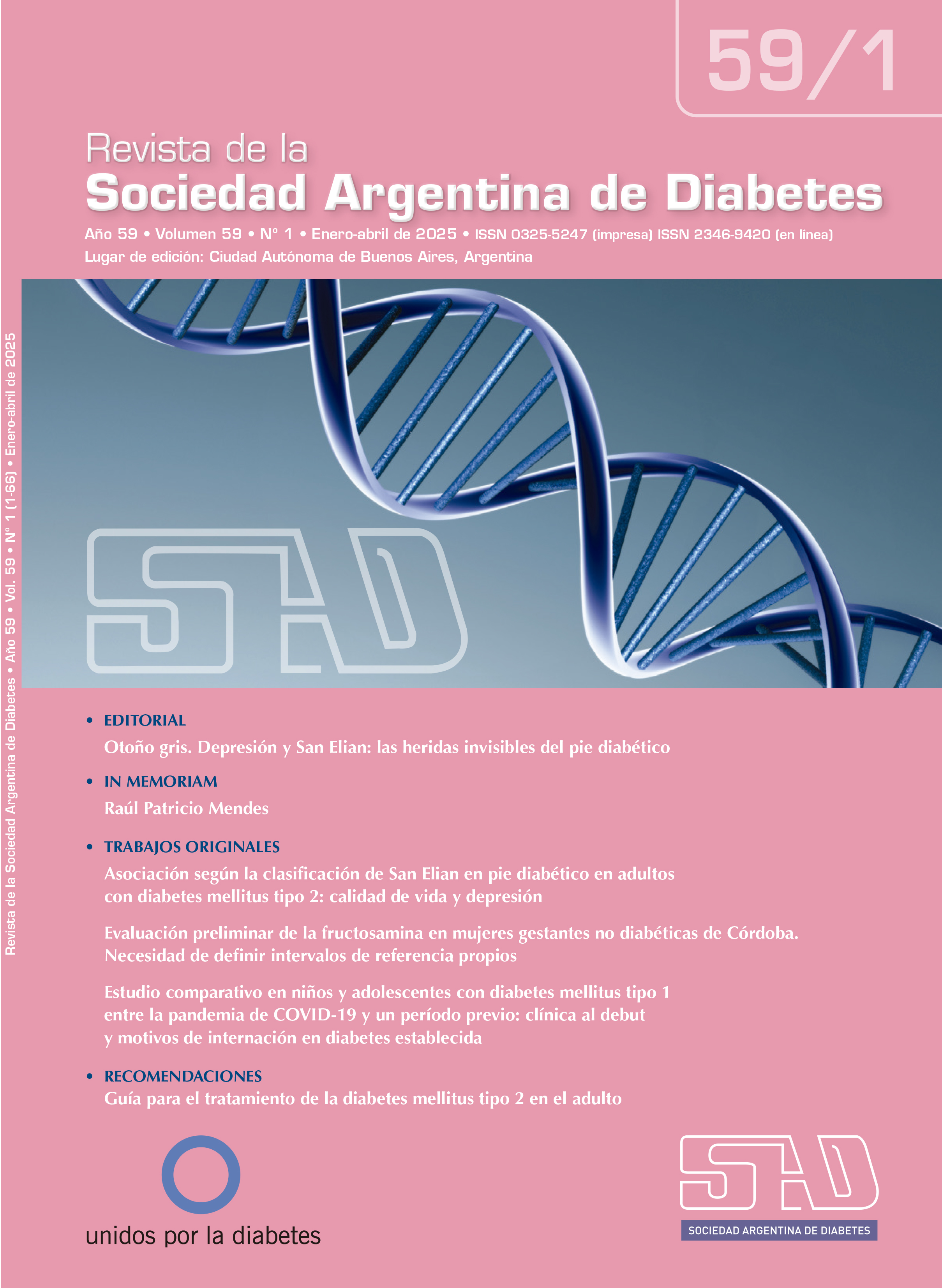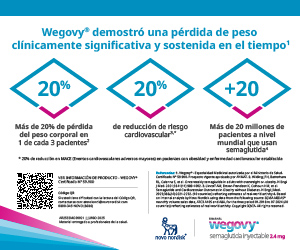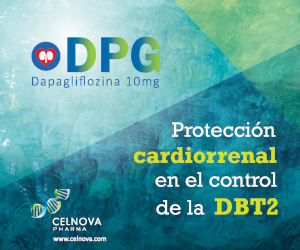Association according to the San Elian classification in diabetic foot in adults with type 2 diabetes mellitus: quality of life and depression
DOI:
https://doi.org/10.47196/diab.v59i1.1160Keywords:
diabetic foot, San Elian classification, depression, quality of life, diabetes mellitusAbstract
Introduction: diabetic foot (DF) is one of the main causes of non-traumatic amputation of lower limbs; its lesions directly impact the quality of life and the emotional state of the patient, which requires a long follow-up period to achieve healing of ulcers, an extensive period of rest by the patient, and the assistance of family members and/or third parties to carry out the instructions corresponding to healing and collaborate with the tasks of daily life of the person suffering from it.
Objectives: to analyze in adult patients with DF according to the San Elian classification the presence of depression and the characteristics of the quality of life; to study the extension and severity of DF according to personal history, clinical characteristics and laboratory markers; to evaluate the incidence of complications for each DF group according to the degree of severity using the San Elian scale and cases of recurrence.
Materials and methods: cohort study that included 106 adult patients with type 2 diabetes mellitus (DM2) and PD from a public hospital in the Province of Buenos Aires. They were categorized according to severity by San Elian classification (CSE) into three groups according to the San Elian scale (topographic and anatomical characteristics, presence of ischemia and vascular components) and were followed for a period of up to 9 months of treatment (from September 2022 to May 2023). At the beginning and at the end of the follow-up period or in case of discharge, the Hamilton Depression Rating Scale (HDRS) and the modified Diabetes Quality of Life Questionnaire (EsDQoL) were applied. Laboratory and clinical markers and personal history were analyzed.
Results: the total number of individuals (78 men and 28 women) was grouped according to the CSE, with 7.5% having grade I, 84.9% grade II and 7.5% grade III. The mean age in men was 64 and in women 70 years (p=0.007 Chi2); the mean duration of DM2 was 16 years. Of the total population studied, the difference was recorded with respect to sex in relation to the risk factors for the development of PD for the male sex: a greater number of minor amputations of 42.3% (p=0.008), history of osteomyelitis of 60.3% (p=0.004), peripheral artery disease of 65.4% and hospitalization of 33.3%. The female sex registered more major amputations with 17.9% and 25% for revascularization (p=0.032). No significant differences were recorded between the level of depression and the degree of PD, but when comparing each group according to the severity at the beginning and at the end of depression, the tendency decreased.
Conclusions: during the follow-up, the association between the degree of severity of PD, depression and quality of life was not confirmed, but it cannot be underestimated that the mentioned aspects were improved by obtaining a favorable evolution and healing of the lesions. A high percentage of relapses and complications were recorded, where the emotional and social factors were involved. The application of the San Elian scale proved to be pertinent.
References
I. Schaper N, Van Nette N, Jaap S, Hinchliffe R, Lipsky B. IWGDF Guidelines on the prevention and management of diabetic foot disease 2019. Diabetes Metab Res Rev 2020;36(Suppl 1):e3266. doi: 10.1002/dmrr.3266.
II. Ministerio de Salud de la Nación. Guía de atención de pacientes amputados. 2018. Disponible en: https://www.argentina.gob.ar/sites/default/files/inareps-guia-atencion-pacientes_amputados.pdf.
III. Ocampo-Barrio P, Landeros-González D, Méndez-Rojas L. Frecuencia de depresión en pacientes con y sin pie diabético. Revista Española de Medicina de familia;2010;36(9):491-496. doi: 10.1016/j.semerg.2010.04.010
IV. American Psychiatric Association (APA). Diagnostic and Statistical Manual of Mental Disorders, 5th edition, Text Revision (DSM-5-TR). Disponible en: https://www.mredscircleoftrust.com/storage/app/media/DSM%205%20TR.pdf.
V. Lemus N, Parrado R, Quintana G. Calidad de vida en el sistema de salud. Revista Colombiana de Reumatología. 2014; 21(1):1-3. doi: 10.1016/S0121-8123(14)70140-9.
VI. Linari M, González C, Dieuzeide G, Badia M, Argerich M, Echenique M. Calidad de vida y prestaciones en salud de pacientes con diabetes mellitus tipo 2 según región geográfica en Argentina. Rev Soc Arg Diab 2019;53(3).
VII. Martinez de Jesús F, Ibrahim A, Rodríguez-Ramírez N, Zambrano-Loaiza E. El sistema latinoamericano de San Elian para el triage del ataque de pie diabético. Cirugía y Cirujanos 2023;89(5). doi: 10.24875/ciru.20000283.
VIII. Bobes J, Bulbena A, Luque A, Dalfre R, GVEEP. Evaluación psicométrica comparativa de las versiones en español de 6, 17 y 21 ítems de la Escala de valoración de Hamilton para la evaluación de la depresión. Medicina Clínica 2003;120 (18):693-700. doi: 10.1016/S0025-7753(03)73814-7.
IX. Millán M. Cuestionario de calidad de vida específico para la diabetes mellitus (EsDQOL). Atención Primaria 2002;29(8):517-521. doi: 10.1016/S0212-6567(02)70623-9.
X. Ministerio de Salud Argentina. Guías alimentarias para la población Argentina 2017. Disponible en: https://www.argentina.gob.ar/sites/default/files/bancos/2020-08/guias-alimentarias-para-la-poblacion-argentina.pdf.
XI. Jones A, Staniszewska A, Hinchliffe R. Diabetic foot disease. Assessing adherence of national acute and screening referral pathways with NICE guidelines. Diabet Med 2024. doi: 10.1111/dme.15478.
XII. Velásquez-Cabrera AJ. Clasificación de San Elian y su uso para establecer severidad en úlceras en pie diabético. Revista de Ciencia Multidisciplinaria CUNORI 2023; 7(1)141-152. doi: 10.36314/cunori.v7i1.214.
XIII. Waitman J, García B, Lozano M, Cuniberti V, Mercado N. Factores de riesgo asociados al desarrollo de úlceras en pacientes con diabetes tipo 2: siete años de experiencia. Rev Soc Arg Diab 2018;52(1). doi: 10.47196/diab.v52i1.79.
XIV. Carro G, Saurral R, SF, Whitman E, Carrió L, Duturo C. Estudio de diabetes mellitus y pie diabético en la internación: datos de Argentina. Rev Soc Arg Diab 2019;53(1). doi: 10.47196/diab.v53i1.136.
XV. Fu-Hui Jiang, Xiao-Man Liu, Hai Rong Yu, Yan Qian, Hong Lin Chen. The incidence of depression in patients with diabetic foot ulcers, A systematic review and meta-analysis. The International Journal of Lower Extremity Wounds 2022; 21(2):161-173. doi: 10.1177/1534734620929892
XVI. Ismali K, Winkley K, et al. A cohort study of people with diabetes and their first foot ulcer: the role of depression on mortality. Diabetes Care 2007;30(6):1473-1479. doi: 10.2337/dc06-2313.
XVII. Parodi L, Agreda J, García F. Calidad de vida y cicatrización en los pacientes con úlceras de pie diabético en el ámbito latinoamericano. Gerokomos 2021;32(4).
XVIII. Calvagno M. Pie diabético. Recomendaciones de la Federación Internacional de Diabetes 2017. Rev Soc Arg Diab 2018; 52(1). doi: 10.47196/diab.v52i1.78.
XIX. Polikandrioti M, Vasilopoulos G, Koutelekos J, Panoutsopoulos G, Georgiana G, Alikari V, Dousis E, Zartaloudi A. Depression in diabetic foot ulcer. Associated factors and the impact of perceived social support and anxiety on depression. Int Wound J. 2020;17(4):900-909. doi: 10.1111/iwj.13348.
Downloads
Published
Issue
Section
License
Copyright (c) 2025 on behalf of the authors. Reproduction rights: Argentine Society of Diabetes

This work is licensed under a Creative Commons Attribution-NonCommercial-NoDerivatives 4.0 International License.
Dirección Nacional de Derecho de Autor, Exp. N° 5.333.129. Instituto Nacional de la Propiedad Industrial, Marca «Revista de la Sociedad Argentina de Diabetes - Asociación Civil» N° de concesión 2.605.405 y N° de disposición 1.404/13.
La Revista de la SAD está licenciada bajo Licencia Creative Commons Atribución – No Comercial – Sin Obra Derivada 4.0 Internacional.
Por otra parte, la Revista SAD permite que los autores mantengan los derechos de autor sin restricciones.




























